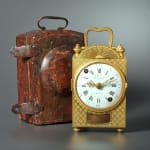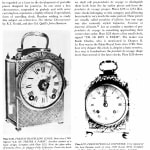
Charles Allix, “Carriage Clocks, Their History and Development”, 1974, p. 21, pl. 1/26 illustrating a travelling clock of circa 1780 signed J B Du Tertre à Paris housed in a very similar case, likewise with a foliate trellis design and arched top; with glazed sides but without the glazed pendulum aperture below the dial, formerly in the Pérez de Olaguer-Felíu Collection.
Végéax (or Végéaux)
Literature
Charles Allix, “Carriage Clocks, Their History and Development”, 1974, p. 21, pl. 1/26 illustrating a travelling clock of circa 1780 signed J B Du Tertre à Paris housed in a very similar case, likewise with a foliate trellis design and arched top; with glazed sides but without the glazed pendulum aperture below the dial, formerly in the Pérez de Olaguer-Felíu Collection.
A Louis XVI gilt bronze travelling clock of eight day duration, signed on the white enamel dial Végéax (or Végéaux) à Roüen. The dial with Roman and Arabic numerals with an inner ring for the 31 days of the month (odd numbers only), with a fine pair of gilt brass hands for the hours and minutes and a blued steel pointer for the calendar indications, with rare asymmetrical winding holes and a further winding hole above 12 o’clock (accessible when the door is open) for regulation of the pendulum. The twin barrel movement with anchor escapement, silk thread suspension, striking on the hours and half hours with outside count wheel. The case with glazed viewing panels to the sides and back, surmounted by a loop handle, finials to each of the corners, with a sunburst arched top and shaped glazed viewing aperture below the dial, ornamented overall with lattice work enclosing flower heads, on turned feet. With a brown leather travelling case
Rouen, date circa 1780
Height with handle 24 cm, width 12 cm, depth 10 cm.
This handsome travelling clock belongs to a group known as pre-pendules de voyage. They predate the carriage clock proper by bridging a gap between the static mantel clock and the more portable carriage clock that instead of having a pendulum was spring driven, to enable reliability during transit. The first pendules de voyage date from about 1775. By then journeys for the more affluent had become easier. Travel was also more desirable, for this was the age of the Grand Tour when gentlemen were encouraged to journey across Europe to see the sights, view recently excavated Classical ruins and return home with a plethora of arts and artefacts. In the same way, it was equally important for army officers to be able to accurately record time. For this reason, these pre-pendules de voyage were also known as pendules d’officier. The present clock typifies many characteristics of these early travelling clocks. Firstly it has a large white enamel dial to make visibility easier under difficult circumstances. Its distinctive arched top and carrying handle that can be easily folded down aided portability and at the same time, its slightly squat and solid construction would enable it to withstand the rigours of travel across rough terrains. It also was fitted with a sturdy leather bound travelling case for protection during transit.
Whilst a functional item, like all luxury clocks, it is beautifully decorated. The trellis and floral decoration and indeed the overall design, with its arch at the top of the case to hide the surmounting bell as well as glazed sides and back, compares closely with another travelling clock of the same period, with a movement by Jean-Baptiste Dutertre (noted above). Charles Allix compared the latter clock with another of the same date by Basile Charles Le Roy (illustrated ibid, p. 20, pl. 1/25). The present travelling clock can also be compared to two by the Rouen clockmaker Frédéric Duval (d. after 1783). One was in the Vitale Collection (illustrated in Vitale & Vitale, “The Carriage Clock: 200 Years of Timely Allure”, 1994, p. 3) and the other was previously sold by this gallery (illustrated in “Richard Redding Antiques Ltd, Masterpieces of the Past”, 2009, p. 57). As here both by Duval were made in Rouen, they are of very similar design to include the same finials, feet, handle, arch above the dial and glazed sides, which would suggest that the cases were all made by the same bronzier. While the Duval clock, previously sold at this gallery, also includes a lunar dial as well as complex calendar indications, it too has asymmetrical winding holes, which was rare. The present clock is signed Végéax (or perhaps Végéaux) à Rouen, whose identity remains a mystery for no late eighteenth century clockmaker working in Rouen of the same or even similar name is recorded in Tardy or any other listings. One wonders therefore if the name may refer to the retailer.


